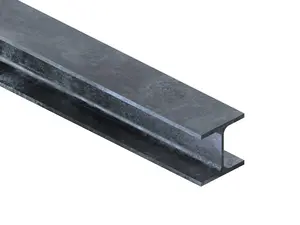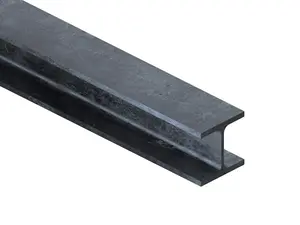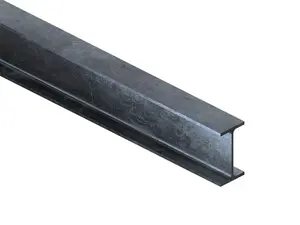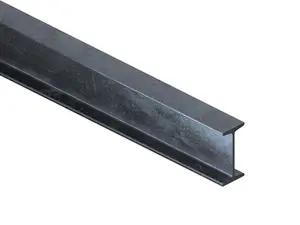Every solid steel structure depends on its foundations, and steel I-beams are one of the key elements of those foundations. As an integral part of many structures, from commercial buildings to industrial steel structures, I-beams provide the stability and durability needed to maintain safety and efficiency.
Characteristics of I-beams
I-beams are extremely popular steel sections with a shape similar to the letter "H" in cross-section, which gives them the unique ability to distribute loads evenly along both the vertical and horizontal axes. Thanks to this design, I-beams are not only strong, but also very stable.
HEA steel I-beams have a wide footprint and relatively short wings, making them lighter and more economical, but still providing adequate strength. HEB I -beams, on the other hand, have a more solid and wide design, which increases their load-bearing capacity and is preferred in areas with heavier loads. IPE I-beams, with their narrower design, are more versatile and represent a compromise between weight and strength. In contrast, IPN I-beams, with a specific profile similar to the letter "I," focus on optimized strength at the lowest possible weight.
The manufacture of steel I-beams mainly relies on the hot-rolling process. In this technology, the steel is heated to very high temperatures and then passed through specially constructed rolling mills that shape it into the desired I-beam profile. This hot rolling process not only ensures precise dimensions and shapes, but also guarantees excellent material uniformity, which translates into high mechanical properties and product durability.
Features and advantages of I-beams
Features of I-beams:
- HEA I-beam - is characterized by a wide base area and relatively short wings. Lighter construction compared to other I-beams.
- HEB I-beam - massive and wide structure, providing greater load-bearing capacity and resistance to loads.
- IPE I-beam - a narrower profile than HEA and HEB, offering a compromise between weight and strength. Versatility in terms of application.
- IPN I-beam - profile similar to the letter "I", optimized strength with the lowest possible weight. Narrower wings compared to IPE.
Advantages of I-beams:
- Material optimization - thanks to precise design, I-beams guarantee adequate strength with optimal material weight.
- Versatility - the availability of various types of I-beams (HEA, HEB, IPE, IPN) makes it possible to adapt them to a wide range of construction requirements.
- Excellent weldability - I-beams made of the right quality of steel are characterized by excellent weldability, allowing the creation of durable and solid connections.
- High stability - thanks to their shape, I-beams effectively distribute loads, ensuring structural stability.
- Resistance to deformation - the robust design of I-beams makes them resistant to deformation under loads.
Steel grades
S235JR steel (1.0038)
Features:
- Low-alloy structural steel with excellent weldability.
- The chemical composition is characterized by a maximum carbon content of 0.17%.
- Provides adequate mechanical properties for standard loads.
Advantages:
- High weldability without the need for additional pre-treatments or the use of specialized welding additives.
- Favors machining such as turning, bending and cold working.
- Features ductility and good fracture toughness.
Disadvantages:
- Mechanical strength is lower compared to higher quality steels such as S355J2.
- Under certain conditions, it may require additional surface treatment to increase corrosion resistance.
S355J2 steel (1.0577)
Features:
- Low-alloy structural steel with improved strength.
- Chemical composition includes small amounts of carbon, manganese, silicon, phosphorus and sulfur.
- It exhibits significantly higher tensile strength compared to S235JR.
Advantages:
- High strength and hardness make it an excellent choice for structures subjected to heavy loads.
- It can be welded with minimal risk of defects and cracks.
- Its higher strength allows it to achieve the same structural performance with less material weight.
Disadvantages:
- The price is higher compared to S235JR steel.
- In specific applications, it may require additional heat treatment to achieve the desired mechanical properties.
Applications of I-beams
I-beams are an important component in steel structures, playing a key role in construction and engineering. Thanks to their characteristic "H" or "I" cross-sectional shape, I-beams have a unique ability to distribute loads efficiently, which translates into their wide application in a variety of projects.
- HEA I -beams - due to their specific shape and wide base are widely used in structures where the main goal is to achieve adequate strength while saving weight. They are used in steel structures of buildings, bridges and other structures with medium loads.
- HEB I-beams - provide greater strength and are mainly used in heavy-duty structures. Their massive structure makes them an ideal choice for the construction of bridges, large industrial halls or tall buildings, where significant load-bearing capacity is required.
- IPE I-beams, a compromise between weight and strength, are versatile in use. They are eagerly used in structures with medium loads, such as building frames, support structures or structural elements of machinery.
- IPN I-beams - designed to offer optimized strength with minimal weight, are particularly useful in structures where lightness and, at the same time, load resistance are required. They are used in industrial construction, machine structures and other places where a combination of performance and economy is desired.
Advice for investors
- Careful analysis of needs - before making a purchase, carefully determine the specifications and required dimensions of I-beams that will best meet the requirements of your project.
- Steel quality - make sure the I-beams are manufactured from high-quality steel that meets the required industry standards.
- Use of a specific type - choose the appropriate type of I-beams (HEA, HEB, IPE, IPN) based on the loads and structural requirements of the project.
- Transportation and logistics - make sure the supplier is able to provide adequate transportation and delivery conditions, especially for larger orders.
Storage of I-beams
Proper storage of steel I-beams is key to maintaining their quality and functionality. Our recommendations:
- Horizontal storage - steel I-beams should be stored horizontally on even and stable supports to avoid bending. Even support - to maintain the structural integrity of I-beams, supports should be spaced at regular intervals to ensure even weight distribution.
- Corrosion protection - ensure that steel I-beams are stored in a dry environment, protecting them from the elements. If stored outdoors, use tarpaulins or other protection.
- Stack spacing - it is recommended to maintain adequate spacing between stacks of I-beams to ensure air circulation and avoid moisture accumulation.
- Avoid contact with aggressive substances - steel I-beams should not be stored in the vicinity of chemicals or other substances that can lead to corrosion.
Did you know
- The term "I-beam" comes from the double "T" (TT) shape in the cross-section, which is characteristic of these profiles.
- The geometric design of I-beams is optimized to maximize their load-bearing capacity while minimizing the amount of steel used.
- Although they are mainly associated with the construction industry, I-beams have found wide application in many other industries, such as automotive and shipbuilding.
- Modern engineering and technology have made it possible to create hybrid I-beams, which combine steel with other materials, such as aluminum or carbon fiber, to provide better mechanical properties or specific performance characteristics.
I-beams - why with us?
Our product range includes a wide range of I-beams, allowing you to find the perfect fit for any project. Whether you need support for an existing structure or are building from scratch, our steel I-beams guarantee the success of any project.
Check out what we offer and choose the types of I-beams that will work best for your project.
FAQ
What is the difference between HEB and HEA I-beams?
HEB and HEA I-beams are two types of steel profiles that differ mainly in their dimensions and applications. Both are part of the European profile family, also known as "H-profiles."
The HEB I-beam is a large-sized steel profile that is stronger and heavier than the HEA I-beam. HEB offers greater strength and stiffness, making it ideal for applications where high load-bearing capacity and bending resistance are required. HEA I-beam, on the other hand, is a steel profile with slightly smaller dimensions, is lighter and has less strength than HEB.
The main difference between HEB and HEA I-beams relates to their dimensions and strength. The choice between the two depends on the specific requirements of a project.
How much does an I-beam cost?
The price of I-beams can vary significantly depending on a number of factors, such as the type and dimensions of the I-beam, the material from which it is made (e.g. stainless steel, carbon steel) and current market conditions for steel raw materials.
Due to these factors, the prices of I-beams can range from tens to hundreds of zlotys per running meter. Check the price of the selected I-beam from our offer!




